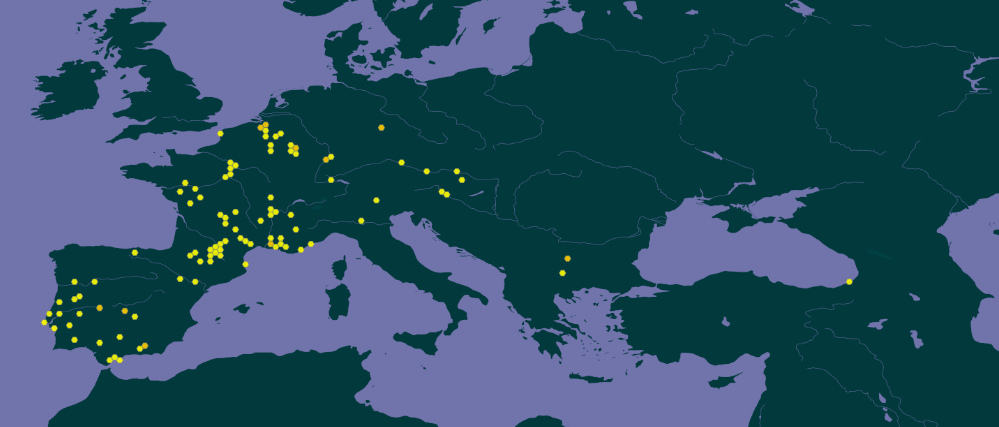 |
n/a | Status LU: established. 1st record: 2008. |
 |
Biergerlech Mauerspann1 | Status Eur.: established. |
 |
n/a | RA: ISEIA: C3. Harmonia+: n/a. |
 |
Echte Mauerspinne2 | Wikipedia: |
 |
Zuiders kaardertje | Back to the list of invertebrates |
Contents
Brief description
 Brigittea civica (Lucas, 1850) is distributed in Europe, North Africa, Turkey, Iran and introduced to North America (Nentwig et al. 2020). In Central Europe, it is mainly known as a resident of house facades, which gave it the trivial name “wall spider”. On structured walls it spins around its hiding place, usually a recess in the plaster, a ruffled web up to the size of a palm. In this net not only the prey of the spider is caught, but also street dust, so that the settlement of even light-coloured house walls can be easily recognised from a distance (Hohner 2019). The species occurs synanthropically in central European conditions. It is well adapted to coexistence with humans, and since there is no natural enemy, it may freely redistribute (Novotný et al. 2017).
Brigittea civica (Lucas, 1850) is distributed in Europe, North Africa, Turkey, Iran and introduced to North America (Nentwig et al. 2020). In Central Europe, it is mainly known as a resident of house facades, which gave it the trivial name “wall spider”. On structured walls it spins around its hiding place, usually a recess in the plaster, a ruffled web up to the size of a palm. In this net not only the prey of the spider is caught, but also street dust, so that the settlement of even light-coloured house walls can be easily recognised from a distance (Hohner 2019). The species occurs synanthropically in central European conditions. It is well adapted to coexistence with humans, and since there is no natural enemy, it may freely redistribute (Novotný et al. 2017).
Status and distribution in Luxembourg
Records of Brigittea civica (Lucas, 1850) in Luxembourg. Data source: Recorder-Lux, iNaturalist & GBIF, 2025-12-18.
The status of the species seems unclear in other European countries, e.g. in the Czech Republic, where it is considered to probably be non-native; furthermore a study suggests that Brigittea civica is much more common than was previously mapped and the presence of this species in the Czech Republic was underestimated (Novotný et al. 2017).
Risk assessment
ISEIA protocol
C3 (2+1+2+1) (Ries et al. 2017: 68).
Harmonia+ protocol
Not assessed yet.
Distribution in Europe
Worldwide distribution
Bibliography
- CABI, 2019. Brigittea civica (Lucas, 1850) . In: Invasive Species Compendium. Wallingford, UK: CAB International. URL: www.cabi.org/isc [accessed 2020-03-04]
- GBIF, 2020. Brigittea civica (Lucas, 1850) in GBIF Secretariat (2019). GBIF Backbone Taxonomy. Checklist dataset https://doi.org/10.15468/39omei [accessed 2020-03-04]
- Hohner, M., 2019. Neue Nachweise von Brigittea civica (Araneae: Dictynidae) in Bayern. Arachnologische Mitteilungen: Arachnology Letters 57(1): 84-86.
- MNHNL, iNaturalist & GBIF, 2020. in MNHNL-mdata, online portal combining species observation from Recorder-Lux, iNaturalist and GBIF. National Museum of Natural History, Luxembourg. URL: https://mdata.mnhn.lu [Accessed 2020-03-04]
- Nentwig W, Blick T, Bosmans R, Gloor D, Hänggi A, Kropf C, 2020. Version {2}.2020. Online at https://www.araneae.nmbe.ch. https://doi.org/10.24436/1 [Accessed 2020-03-04]
- Novotný, B., V. Hula & J. Niedobová, 2017. Insufficiency in Distributional Faunistic Data in Synanthropic Spiders: a Case Study of the Occurrence of Brigittea Civica (Araneae, Dictynidae) in South Moravia, Czech Republic. Acta Universitatis Agriculturae et Silviculturae Mendelianae Brunensis 65(3):899-906. DOI: 10.11118/actaun201765030899
- Ries, C., A. Arendt, C. Braunert, S. Christian, A. Dohet, A. Frantz, G. Geimer, M. Hellers, J. A. Massard, X. Mestdagh, R. Proess, N. Schneider & M. Pfeiffenschneider, 2017. Environmental impact assessment and black, watch and alert list classification after the ISEIA Protocol of invertebrates in Luxembourg. Bull. Soc. Nat. luxemb. 119: 63-70. [PDF 360 KB]
- Wiki der Arachnologischen Gesellschaft e. V.-Bearbeiter, 2020. Brigittea civica. Wiki der Arachnologischen Gesellschaft e. V. URL: https://wiki.arages.de/index.php?title=Brigittea_civica&oldid=118852 [accessed 2020-03-05]
Page content last updated on 2020-12-08.



















